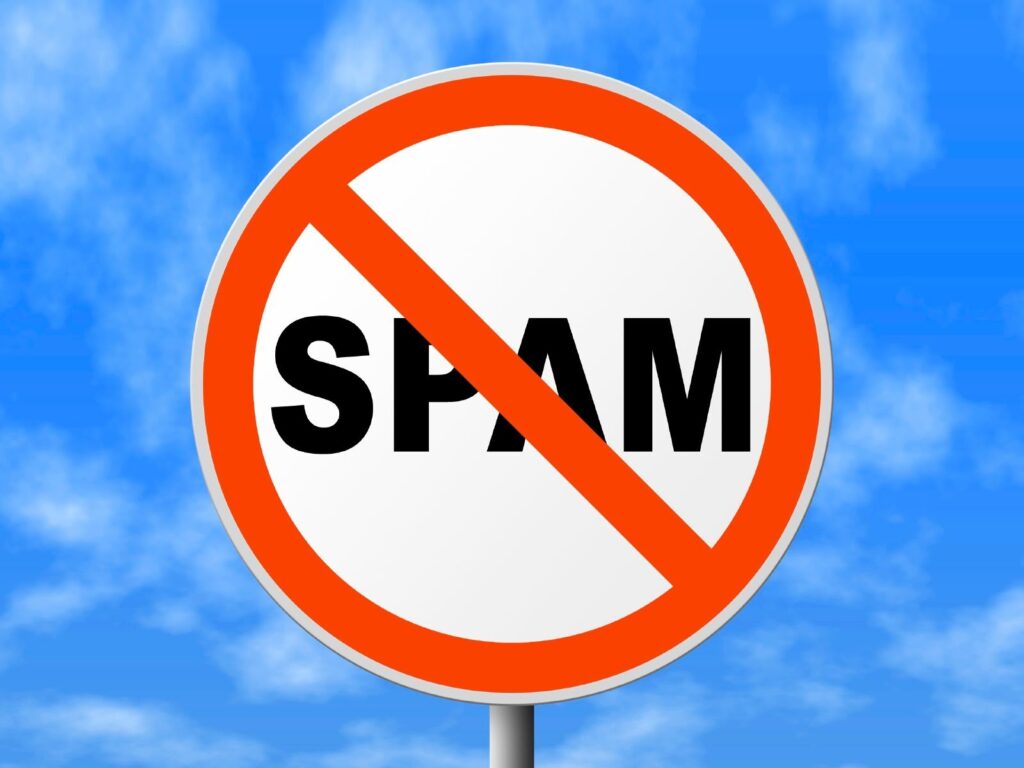Google & Renegade Linking Practices

Google webspam report: Cracking down on renegade linking practices, auto-generated content. “More than 25 billion pages we discover each day are spammy,” the company revealed. Google discovers more than 25 billion spammy pages a day, according to its annual webspam report released Tuesday. The company also published a companion post on why it’s important to keep spam out of search results. The definition of spam. “We define ‘spam’ as using techniques that attempt to mimic [high quality content] signals without actually delivering on the promise of high-quality content, or other tactics that might prove harmful to searchers,” the post reads. A more comprehensive list of spammy behaviors can be found on Google’s Webmaster Guidelines. How Google stops spam. In the majority of cases, Google automatically identifies spammy behavior and ensures that those pages don’t rank well in search results. The company also uses human analysts to determine if content or sites are spammy. The human review process often leads to improved automated systems. “We look to understand how that spam got past our systems and then work to improve our detection, so that we catch the particular case and automatically detect many other similar cases overall,” the post reads. Spammy content is often demoted or removed completely from the search results. Google may also give site owners the opportunity to resolve issues by sending them manual actions via Google Search Console. Below are some figures that the company emphasised in its webspam report: > Google says its efforts ensure that more than 99% of visits from its results lead to spam-free experiences. > Paid links and link exchanges have been made less effective, with Google catching more than 90% of link spam. > In 2018, it reduced user-generated spam (spam accounts on forums, blogs, and other platforms, as well as the posts they create) by 80%; “this type of abuse did not grow in 2019,” the company said. > The impact of spammy sites (those that feature auto-generated or scraped content) on search users has been reduced by more than 60% compared to 2018. > Google received nearly 230,000 search spam reports in 2019 and was able to take action on 82% of them. > The company generated over 90 million messages to site owners about issues that may affect their site’s appearance in search results as well as potential improvements. > Roughly 4.3 million messages were sent regarding manual actions resulting from Webmaster Guidelines violations.
How Long Does SEO Take?

You’ve most likely spent a lot of money on getting a website that ‘sells’ your products/services, but what good is it going to do your business if people don’t see it? But how long does a project take? While there are no definitive answers as each project is different, as a guide, there are a few factors to consider when trying to gauge how long an SEO campaign will take, such as: How new your site is Sites that are brand new often have a “sandbox” period where they will not see good rankings for months. For the sake of SEO, it is best to launch your site as quickly as possible with some content, even if you are still adding pages and filling out the site. How competitive your niche is The more competitive your niche and the more competitive your keywords are, the longer it usually takes to rank for terms. Why you don’t have rankings now If your site is poorly optimised or has technical issues, fixing those things could result in huge improvements within a few weeks or less. Likewise, if your site is lacking content, adding more keyword-rich content could also boost ranking significantly or at least put you into the search results if you weren’t there before. Website authority and relevance However, if your site isn’t ranking due to lack of authority or lack of relevance, it can take much longer to rank your site, since building authority and relevance can take quite a while. Generally speaking, we recommend sticking with an SEO campaign for at least 6 months, which should be enough time to see significant improvement for most niches. However, usually, it is possible to see at least some results within 2-3 months, especially if you are not ranking due to technical issues and/or poor optimization – both of which can usually be fixed within the first month or two, depending on the size of the site and the depth of the issues. Whether you are a small local business or a large company, being seen online can now be crucial to ensuring business success. But as more businesses move online, your website can easily get lost in the thousands of millions of results – but only if you don’t have the right help. At Direct Submit, we believe every company is unique and we deliver a specific range of SEO services designed to help ensure the optimum performance of your website. With over 15 years of experience our goal is to increase the visibility & exposure of your business simply by generating more organic traffic to your Website.
Google Explains Content Pruning Best Practices

Google’s John Mueller on how to identify pages to block. Then he explains why some low traffic pages are okay. In a Google Webmaster Hangout, Google’s John Mueller answered which low traffic pages to noindex and which ones to not worry about. Are Low Traffic Pages Harmful? It’s generally understood that it’s a good idea to remove low performing pages. Low-quality pages tend to attract low amounts of traffic and should be either no-indexed or removed entirely. That is what the question John Mueller answered is about. The question is specifically about a news site but Mueller’s answer widens to be useful to more than just news sites. This was the question: We’re publishing news and articles. For example, we have 100 new articles every day and ten of them give us 95% of the organic search traffic. Another 90 go nowhere. We’re afraid that Google can decide our website is interesting only for 10%. There’s an idea to hide some boring local news under noindex tag to make the overall quality of all publishing content better. What do you think? Google’s Mueller first discusses how Google’s algorithm reviews web pages and the entire site in order to understand what the quality level is. His answer was on a general level, meaning that it’s applicable regardless if it’s a news site or any other kind of site. This is what Mueller said: “In general, we do look at the content on a per page basis. And we also try to understand the site on an overall basis, to understand how well is this site working, is this something that users appreciate. If everything is essentially working the way that it shout be working. So it’s not completely out of the question to think about all of your content and think about what you really want to have indexed”. Now Mueller focuses on news sites. He states that traffic isn’t necessarily the metric to use for judging whether a news web page is low quality. But especially with a news website, it seems pretty normal that you’d have a lot of articles that are interesting for a short period of time, which are perhaps more of a snapshot from a day to day basis for a local area. And it’s kind of normal that they don’t become big, popular stories on your website. So from that point of view, I wouldn’t necessarily call those articles low-quality articles, for example. So, just because a news article isn’t popular doesn’t mean it’s low quality. John Mueller then advises on how to know when content is truly low quality. He highlights issues such as content that is hard to read, broken English, and content that is poorly structured. Then he says what to do if you have a mix of good and poor quality content. On the other hand, if you’re publishing articles from … hundreds of different authors and they’re from varying quality and some of them are really bad, they’re kind of hard to read, they’re structured in a bad way, their English is broken. And some of them are really high-quality pieces of art, almost that you’re providing. Then creating that kind of a mix on a website makes it really hard for Google and for users to understand that actually you do have a lot of gems on your website… So that’s the situation where I would go in and say, we need to provide some kind of quality filtering, or some kind of quality bar ahead of time, so that users and Google can recognize, this is really what I want to be known for. And these are all things, maybe user-submitted content, that is something we’re publishing because we’re working with these people, but it’s not what we want to be known for. Then that’s the situation where you might say, maybe I’ll put noindex on these, or maybe I’ll initially put noindex on these until I see that actually they’re doing really well. So for that, I would see it making sense that you provide some kind of quality filtering. But if it’s a news website, where… by definition, you have a variety of different articles, they’re all well-written, they’re reasonable, just the topics aren’t that interesting for the long run, that’s kind of normal. That’s not something where I’d say you need to block that from being indexed. Because it’s not low-quality content. It’s just less popular content.
Delving into Digital Marketing

Digital marketing is the marketing and advertising of a business, person, product, or service using online channels, electronic devices, and digital technologies. A few digital marketing examples include social media, email, pay-per-click (PPC), search engine optimisation (SEO), and more. How is digital marketing different from traditional marketing? The difference between traditional marketing and digital marketing is simple. Traditional marketing uses offline channels, while digital marketing uses online channels. A traditional marketing campaign, for example, may use billboards, radio ads and news stories, while a digital marketing campaign may use social media, blog posts, and email to promote a business and its offerings. Delving into Digital Marketing Why is digital marketing important? For companies today, digital marketing matters because it offers: > Multiple online marketing strategies > Cost-effective marketing solutions > Level playing field > Advanced targeting and personalisation options > Accurate campaign tracking and measurement > Continuous campaign performance feedback Digital marketing offers multiple online marketing strategies With online marketing, your company can pick from a range of tactics, including: > SEO > PPC > Content marketing And more… Delving into Digital Marketing further, you find you have many options, which is not the case when using traditional marketing. With traditional marketing, you have fewer choices. You only have a couple of channels available, like radio, print, and TV, and many of these channels are expensive, which limits your choices further. Digital marketing offers cost-effective marketing solutions Price is another benefit of digital marketing. Compared to traditional marketing, online marketing is extremely cost-effective. If you advertise online, whether on social media, websites, or search engines, you set your budget and bid for ad space. You have complete control over how much you spend, which is not the case when buying a billboard. Plus, you can stop your strategy at any time. If you launch a PPC campaign, for instance, and see that it is not performing, you can go ahead and pause that campaign. In comparison, once you buy a billboard, you have it for that entire duration, whether it works or not. Digital marketing offers a level playing field If you are a small to mid-sized business (SMB), digital marketing also helps your company stand apart from larger brands. That is because online marketing offers cost-effective solutions, like SEO, that can help your business reach its audience. With SEO as a digital marketing strategy, for example, your business can optimise your content for long-tail searches, or searches that feature three or more words, like “car maintenance services” or “how to clean house gutters.” This approach can help your company bypass big brands and reach your target market. You do not have to worry about how your online marketing budget will compete with larger brands, either. Digital marketing offers several cost-effective strategies, including SEO, that you can use to get your products or services in front of your audience. For more information on anything to do with Digital Marketing give Direct Submit a call on 0845 2722350 or visit our Digital Marketing Services website. With offices in both Durham and Newcastle, we can help you do just that through Digital Marketing and Search Engine Optimisation (SEO).
All About Domain Authority

Firstly what is the term “Domain authority” and how important is it really? This term was created by Moz as they believed it to be behind how a website performs on the search engines. You all must have heard about Alexa and Google Page Rank but do you know how important they really are? Moz mentioned the use of Domain authority when comparing two sites against each other. They mentioned about calculating the strength of the Domain authority by a combination of link metrics such as number of total links, MozRank, MozTrust, linking root domains etc. They will then come up with a score. All in all, what Moz created was a combination of different factors which graded the domain in terms of authority and strength. Now no one knows if this is really correct or not but we would not advise to completely rely on such software as no one can predict how Google’s Algorithm works. How can a website determine all their internal SEO efforts via just software? The rating scales up to 100 and higher you want to go, the tougher it gets in terms of competition. The following are examples of high domain authority sites: Facebook has 100, Google is 100, etc Now you must be eager to know how you can increase your domain authority. Firstly let’s talk about where you can check about your domain authority and learn more about the principles and basics of SEO. According to Moz who developed this software, you can use Open site explorer or the MozBar which is a free SEO toolbar specifically developed to monitor the domain authority score. You can also checkout Moz’s beginner’s guide to SEO which provides a complete guide into Search engine optimization for all the new webmasters out there. How to increase Domain Authority of your site? As we have learnt that there are a various factors involved in calculating the domain authority score therefore it is difficult to increase your score based on just a few methods. For just this reason alone, it is very important to focus on the long term progression and the content on your site. Content is King remember! By adding content you will be adding value to your site, your target market will want to read what you talk about and relate to it for example, a professional plumber might blog about how to clear pipes during winter, this is value to the reader who wants to know this can be done. Also providing a solution via your content will bring you many readers too. Below are some tips and tricks on how to improve your domain authority score Get working on the Social Networks It does seem like the social networks are increasingly getting crucial in the way which they assist the search engines to rank websites and blogs. We all by now understand the part Facebook and twitter have played in relaying information and web content to the mass audience globally. Thanks to the social network it has become easier to engage with your audience than ever before. Quality Content on the website As an avid blogger I understand the importance of the content in the SEO world. If you do not have valuable fresh content then the chances of your site ranking at the top is very little. Just browse through all the top websites out there right now and you will notice that all have great quality content on them. When there is constant supply of fresh, unique content on your site then spiders will want to crawl your site often and you will notice your site getting indexed much quicker too. Through the help of content, one can create a successful brand name too. We all love content that is catered towards us and aims at providing some sort of solutions to the problems we have. Now with social networks it is even easier to share this content easily across various platforms with just a click of a button. If you can write well then you will get to the top pretty quickly and get the deserved exposure for the quality of content you write. Natural Link Building You can have amazing content on your site but you will still need juicy backlinks to keep the traffic flowing and the search engines happy with you. The positive news is that you do not require a lot of trashy low-quality links as they will not enhance your site in any way or form. You should focus more on the best way to build links naturally. Once again if you have quality content on your site, then naturally people will want to link to it. Do not purchase links in a bid to get your ranking to the top as this is bad SEO practice. Avoid companies that offer automated link building as that too is very bad for your site and can result in a penalty too. So there you go, we have broken down what Domain Authority is and how you can enhance the Domain authority of your site by following the few tips we have outlined above. The main advice to all is to understand the importance of having quality content and backlinks on the website. We suggest in creating a long term goal and strategy to follow day in and day out. With time your domain authority will increase and along with it the traffic to your site too! When planning any great SEO campaign, domain authority is one of those terms that crops up time and time again. This is well known to seasoned SEO experts but, for everyone else, just what is domain authority. More importantly, how can it be used to your advantage? Developed by Moz, domain authority is a number – ranging from 1 to 100 – to determine the ‘strength’ and visibility of a website. The higher the number, the stronger the website is. A bigger number indicates better visibility on search engines.
Google Comments on Bad Links and 50% Traffic Loss

A post in the Search Engine Journal discussed Google’s John Mueller comments on the Googles comments on bad links, plus the correlation between bad referral links and a drop in traffic. A publisher told Google’s John Mueller that Google Search Console (GSC) reported over five hundred referring pages from two domains. These referrals correlated with a 50% traffic drop. Google’s John Mueller commented on the correlation between referral links and a drop in traffic. The publisher related that GSC showed referrals from two domains totaling up to four links to each page of their site. When visiting those pages the publisher saw that they were empty, there was no content on those pages. They stated that the appearance of those referring links correlated to a 50% drop in traffic. The publisher asked: “…is this a scenario where the disavow tool makes sense or does Google detect them as unnatural and will ignore them as a ranking signal?” Google’s John Mueller commented on the mystery of the “empty” pages and what those might be: “It’s really hard to say what you’re seeing here. It’s certainly possible there are pages out there that show an empty page to users and then they show a full page to Googlebot.” That is a reference to a page that is showing one page to Google and another page to everyone else. This practice is called cloaking. Mueller is explaining that the possibility that the page might be cloaking. This is an explanation of what the publisher might be seeing and not addressing the second issue of the rankings. Mueller goes on to dismiss the referral pages as technical mistakes rather than a malicious attempt to sabotage the publisher’s rankings. He said: “From that point of view, I would just ignore those pages.” He then suggested inspecting the pages with Google’s Mobile Friendly test to see what the page looks like when GoogleBot sees them. That’s a test for cloaking, to see if a page is showing one page to Google and another page to non-Googlebot visitors. Mueller then commented on the correlation between the referral links and the 50% drop in traffic: “I don’t think this is something that you need to disavow. It probably looks weird in the links report but I really wouldn’t worry about this. With regards to the drop in traffic that you’re seeing, from my point of view that would probably be unrelated to these links. There’s no real situation… where I could imagine that essentially empty pages would be causing an issue with regards to links. So I would just ignore that. If you decide to put them in the disavow file anyway… just keep in mind that this would not affect how we show the data in search console. So the links report would continue to show those. I don’t think there’s any reason to use a disavow file in this particular case. So I would just leave them be.” What Did the Publisher See? What the publisher saw is an old and common phenomenon called referral spam. The original reason for referral spam was that in the early 2000’s certain free analytics programs published lists of referrers in the form of links. That created the opportunity for spamming a site with fake referrals from the spam site to another site in order to create a link from the public analytics page. This analytics page was not linked from any other page of a site. It simply existed at an automatically generated URL. Most sites no longer have those analytics pages. But the practice continues, perhaps in the hopes that if enough publishers click on the links that Google will see it as a form of popularity that would help their rankings. What the publisher in this hangout probably was looking at was a manufactured referral. The referrer was not real. Even the link did not exist. This is typically the case in referrer spam. Does Referrer Spam Hurt Rankings? In twenty years of creating websites, I have never published a site that did not attract referrer spam. Referrer spam and the ghost links to my sites have had no effect on my rankings. Referrer spam is very common. It’s really a non-issue. The reason why the publisher’s site lost fifty percent of their rankings lies in another explanation.
E-Commerce is Booming According to Reports

Retail sales were down 8.7% in March, the steepest decline ever recorded. However in April, e-commerce enjoyed unprecedented growth, aided in part by government stimulus payments. And over the past week, data released by Adobe, Shopify and PayPal reflect the scale of e-commerce gains and even “Black Friday” level traffic and transactions. Double and triple-digit digital sales growth. Adobe’s new “Digital Economy Index” released earlier today found that e-commerce grew sequentially by 49% (which is huge) and individual categories experienced even higher growth. For example, electronics sales were up 58% and daily online grocery sales were up 110%. The data come from “trillions of transactions, tens of millions of products, and thousands of retailers.” Adobe also said that buy-online-pick-up-in-store (BOPIS) orders were up more than 200% year over year in April. This hybrid transaction form, with an online purchase and offline fulfillment is a metaphor for the more digitally integrated future of retail. Adobe also said that prices remained in check or deflated except in two categories: electronics, whose deflationary slide halted in April and online grocery, which saw price increases. By contrast, online clothing prices experienced “the largest April price decrease in years.” As E-Commerce is booming then Merchant demand is exploding, with consumer demand massive. In its first quarter of 2020 earnings report, e-commerce platform Shopify beat analysts’ expectations and announced annual revenue growth of 47% and gross merchandise volume increases (value of sales through the platform) of 46%, while in-store transactions fell 71% because of store closures. Shopify enables e-commerce for both small businesses and larger enterprises. Earlier, in mid-April, Shopify CTO Jean-Michel Lemieux tweeted that the company was experiencing “Black Friday level traffic every day” and adding “thousands” of merchants to the platform during the pandemic. PayPal CEO Dan Schulman echoed this sentiment on his company’s first-quarter earnings call saying, “On May 1st, we had our largest single day of transactions in our history, larger than last year’s transactions on Black Friday or Cyber Monday.” He added that the company was seeing “unprecedented demand” for its products and services: > Roughly 250,000 net new active accounts per day > In April, an all-time record of 7.4 million net new customers > Q2 expectation is 15 million to 20 million net new accounts > Revenue growth of 35% for PayPal online checkout in April PayPal’s integration with Google Merchant Center to enable retailers to onboard organic and paid product listings across Google went live this week. The jobs situation, with more than 30 million people filing for unemployment, clouds the outlook for recovery. However, online spending is a significant bright spot for merchants, brands and the marketers that serve them. As states and stores open up, consumer reaction will be uneven and may be tempered by fear of infection. However, digital commerce is 100% safe, and the buying behaviours that have become established in the past two months are unlikely to go away. In many categories for the foreseeable future, then, consumers are likely to prefer online transactions and BOPIS to in-store visits.
The Importance & Relevance of your Website

The Importance & Relevance of your Website. Business owners and webmasters should understand the importance of having a good website, especially during the current economic climate, one that works well within the major Search Engines. Is your website not being found on major search engines such as Google, Yahoo and Bing, or are you looking for more visitors to your website – potential clients who want to buy your products or services. If you answered ‘yes’ to these questions then you’ve come to the right place. Direct Submit can make your website more “search engine friendly”, making it much more likely to help you get more from your online presence. Search engines use many different factors to determine the importance and relevance of your website. When a user searches, they type in a set of keywords and are presented with a series of results. The more relevant and authoritative your website, the higher up the results page it will appear. That’s where SEO services can assist you in presenting your site effectively by optimising on-page and off-page factors to ensure it ranks highly for the all-important search terms. Search engine optimisation services, such as Direct Submit, can help improve and refine both the relevance and strength of your website thus enabling search engines to favour your site over your competitors. More and more companies are using search marketing services in the UK. To capitalise on that vital organic search traffic, you need to ensure your business isn’t left behind. You need to ensure that your website content is searchable and shareable. How do I get started with an SEO agency and their SEO services? We provide SEO services for UK companies as well as businesses all over the world. All we need for a quotation is: >>> Your website URL. >>> Your chosen primary keywords. Once we receive the above we can review the potential project and provide you with a bespoke proposal. We offer a diverse range of services for businesses, all backed by our commitment to provide a high-quality customer-focused service and great results. Our aim is to provide a progressive SEO solution that will bring constant growth to our client’s website. We offer affordable SEO, Web Design, Pay per Click and Specialist Local Business SEO Services & we take pride in the fact our service delivers the best result. Regardless of the project, we offer unique client-focused SEO Marketing Strategy designed around the clients individual needs. Call us today on 0845 27272350 or visit our Digital Marketing website today for your free SEO quotation.
LinkedIn Drops out of Google Search Results

It seems even the biggest sites on the internet can have problems with their SEO and Google. Early Wednesday morning, the www version of LinkedIn.com, one of the most popular web sites with over 690 million members, dropped out of Google Search. If you tried to find any web pages for www.linkedin.com on Google Search, Google would not show any results. LinkedIn not in Google LinkedIn has hundreds of millions of web pages on the www root domain and none were showing up in Google search. If you did a site command for [www.linkedin.com] in Google search, Google returned this: LinkedIn Drops out of Google Search Results This all started early Wednesday morning, sometime before 4:30am ET, when Andy Levy-Stevenson from Five Blocks notified Search Engine Land. David Sedley, his colleague, then shared more data of LinkedIn dropping like a fly in Google Search. What went wrong? It seems most likely this was an issue on LinkedIn’s end. We asked Google’s PR team and various Googlers about this, but nobody would comment. However, John Mueller of Google posted on Twitter, shortly after the news of LinkedIn came out: “PSA: Removing the ‘http://’ version of your site will remove all variations (http/https/www/non-www). Don’t use removal tools for canonicalization.” This did not appear to be an issue or bug with Google Search, but rather a technical change LinkedIn made. We reached out to some of our friends at Linkedin but we have not heard back by the time of publishing this story. If we hear back, we will update here. All good now. At 1:45pm ET, around 10 hours after the indexing issues were first spotted, LinkedIn began to start showing back up in Google search results. This is a good reminder to the SEO world that even massive web sites can run into Google search issues. We do not know yet why this happened but chances are this was a mistake at LinkedIn. There are several ways sites can (accidentally) remove themselves from the search results — by blocking search crawlers with Robots.txt or the site removal tool in Google Search Console, for example. Maybe someone at LinkedIn pressed the wrong button, uploaded the wrong file, or some other technical issue that resulted Google dropping all these pages from its index. It is back, several hours later and this should not have a material impact on the site’s overall search performance and overall metrics going forward.
Local SEO: Helping your Business

Local SEO is an effective online marketing tool. It basically showcases your website in search results to customers located near you at the exact moment when they need your services. Local SEO marketing is quite different from regular SEO marketing because local search results change very rapidly. Studies show that 97% of consumers now go online to find local services, with 82% of smartphone users use a search engine when looking for a local business or service. Google has been placing a lot of emphasis on local search lists, as much as possible it tries to show local search results for shops, restaurants, doctors, hotels, construction companies, movers and packers and other such businesses. Google Maps often appear in local searches and it’s important that your business appears in such results. If you need an experienced local SEO agency then Direct Submit is the right choice for you. How does Local SEO help? Local SEO marketing helps your business in the following manner: It helps you reach local customers who are most likely to buy from you – Customers searching for products and services in their neighbourhood are mostly looking to buy something. They want to buy from a nearby store or visit a specialist nearby and would always prefer a local store or service than one situated far away. This is why they searched in the first place. Hence such prospects have the highest potential to convert to customers who would remain loyal for years to come. If they are happy with your product offerings, not only would they buy it themselves but also recommend it to their neighbours and friends thus increasing your chances of getting even more local customers. We all know how ‘word of mouth’ is still the most effective way to get business. It helps you engage with local customers online and get customer reviews – Local SEO services helps you reach out to customers in more meaningful ways. You can interact with them on a daily basis with social media or timely offers through emailers and ads. In return, these customers may put out reviews of your service online which not only attracts more customers but also leads to better search rankings and quality score. Direct Submit has a strong team of local SEO experts. We can help your business achieve better results and higher ROI with local SEO. Our team of SEO experts will create a bespoke results-driven strategy to improve your SEO and help to boost your conversions. Ultimately, our SEO services are designed to drive qualified website traffic and leads to your business. Contact us now on 0845 2722350 or visit our website for more details. How do NAP Submissions Help Promote Your Business
